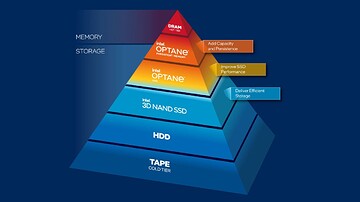Hi, I was wondering if you can use intel persistent memory in a workstation instead of a server? If you can then which workstations or workstation motherboards would it work with?
I’ve been curious to know and I don’t want to make a leap to a server yet. This is just for home/professional use (Student).
Are you sure? Where did you find this information? These modules are labeled as PMEM and T-DIMM. Some desktop grade CPUs don’t even support ECC. I however found no information which platforms are supported.
To my knowledge, and right now I’m researching DDR2 mind you so I could be 100% wrong, absolutely, but depending on if its, old terms because intel can eat my ass, something like an E5 level workstation, or the rare E7 workstation, IDK if desktop related anything will be using that for another 5 yrs at least.
You could have a cool project on your hands though.
According to this link, Optane Persistent Memory is only supported by particular Xeon CPUs:
Yes, a workstation can be built that works with Persistent Memory. But no, it can’t be plugged in to just any workstation.
And here is an Intel link as a starting point for motherboard info:
This is again something different. These motherboards can use the Optane memory that can be plugged into a M.2 slot as a kind of cache, but they can’t use persistent memory.
Intel Ark does have a search filter for CPUs supporting Optane DCPMM (Data Center Persistent Memory Module): Intel® Product Specification Advanced Search
As I understand it, an Optane DCPMM (Data Center Persistent Memory Module) needs a specific CPU, but it sounds as though it is actually sitting on the memory channels of the CPU, rather than a separate interface. Because of this, I am not sure if there needs to be custom design work to modify DDR4 traces, or if any motherboard that sockets those Optane-memory-compatible CPUs would work just as well.
This article has the most detailed explanation of how Optane memory works that I was able to find:
The first two generations of Intel Optane DCPMM or PMem 100 and PMem 200 operate at DDR4-2666 speeds with Cascade Lake and Cooper Lake.
… Once you add PMem to a server, the memory speed drops to DDR4-2666. So on Cascade Lake or the 2nd generation Intel Xeon Scalable that means we go from 6x DDR4-2933 per socket to 6x DDR4-2666. The same happens with the DDR4-3200 3rd Gen Intel Xeon Scalable CPUs as well.
This other article also makes an interesting claim that Optane was not profitable at the listed prices (written 2019-01-21) and that it was or is being subsidised by CPU sales. Edit: On further thought, this claim seems suspicious; unless:
- Optane memory significantly predates Optane SSDs,
- or Optane memory substantially outsells pure-Optane SSDs,
- or Optane dies manufactured for memory or storage (SSD) actually differ in cost,
Optane SSDs, where a specific CPU purchase is not necessary to use the product, would undermine attempts to subsidise additional Optane costs with CPU sales.
https://thememoryguy.com/where-is-microns-quantx/
Optane Forms (for anyone skimming)
Intel sees Optane as a technology that fits somewhere between RAM and storage.
- Optane SSDs are basically Optane-as-Storage, addressable by block (probably either 512 B or 4 KiB)
- Optane Persistent Memory is Optane as quasi-RAM, each byte is individually addressable; sold as DCPMM (Data Center Persistent Memory Module)
Specifically, from Intel’s Affordably Accommodate the Next Wave of Data Demands PDF:
Intel Optane memory media can be packaged in two ways: In a DIMM form factor, as a persistent memory module that sits on the memory bus, or as an NVMe SSD storage device that sits on the PCIe bus.
Was just about to link some STH stuff on this
This topic was automatically closed 273 days after the last reply. New replies are no longer allowed.
